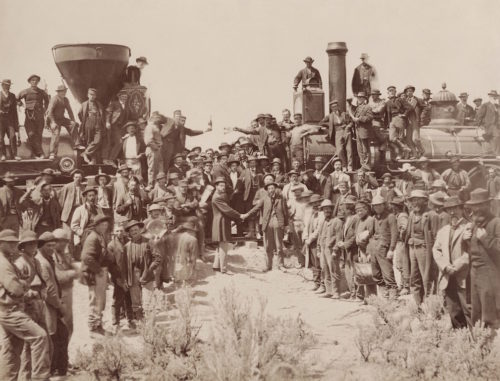
Union Pacific Railroad Chief Engineer Grenville Dodge (center right) shakes hands with his counterpart from the Central Pacific Railroad at the “golden spike” ceremony on May 10, 1869, at Promontory Summit, Utah. Photo courtesy of National Archives
By Michael Morain
With a cloud of steam and a mighty whistle, a huge old train chugged across the country this summer to celebrate the 150th anniversary of the first transcontinental railroad.
After more than two years of meticulous restoration — and almost 60 years out of commission — the Union Pacific’s 1941 “Big Boy” steam locomotive shifted into gear in Wyoming and recently thundered through Iowa. Thousands of folks with cameras and lawn chairs welcomed it to Denison, Carroll, Boone, Nevada, Iowa Falls and Mason City and then, during its return jaunt, through Clinton, Wheatland, Cedar Rapids, Belle Plaine, Marshalltown, Elkhart, Des Moines, Boone, Carroll and Woodbine.
The Iowa tour was a fitting tribute, considering an Iowan helped mastermind the railroad’s construction.
“Grenville Dodge had his hand in everything,” said Tom Emmett, executive director of the Historic General Dodge House on a hill in Council Bluffs.
Dodge stands right in the middle of the famous photo at the “golden spike” ceremony in 1869, between two trains parked nose-to-nose in the Utah mountains. Above him, a worker hangs off one of the engines, lifting a bottle of champagne.
But that moment of triumph — heralded worldwide with the one-word telegraph “DONE” — came after years of hard work and determination by Dodge, the Union Pacific’s chief engineer, and the workers he oversaw. They literally moved mountains.
Grenville Mellen Dodge was born in 1831 near Boston, Mass. He helped survey his first railroad at age 14, studied civil engineering at Norwich University in Vermont and moved to Council Bluffs in 1851 to survey railroads on the frontier.
When the Civil War broke out in 1861, he joined the Union Army and distinguished himself as a shrewd and courageous leader. He climbed the ranks to major general and helped organize a network of more than 100 spies, including women, former slaves and white southerners who were loyal to the Union, whose intelligence tips helped win key battles from Pea Ridge to Atlanta.
Dodge’s railroad experience helped Union troops repair railroads, bridges and telegraph lines that had been destroyed in battle. And at least twice — once in Council Bluffs and once in Washington — President Abraham Lincoln met Dodge to discuss where the future transcontinental railroad should cross the Missouri River. It was Dodge’s advice that led to Council Bluffs.
“Lincoln pulled everything he could out of Dodge’s brain,” Emmett said.
By the time Dodge left the Army, in 1866, his military service had uniquely prepared him for Union Pacific’s urgent campaign to lay tracks across the West.
He understood geography. He stretched resources. He rallied workers and figured out how to provide them food and housing many miles from the nearest town.
Dodge’s papers at the State Historical Society of Iowa show what a multitasker he turned out to be. He served a term in Congress, from 1867 to 1869, even during the peak of his work for the Union Pacific.
The historical society’s manuscripts archivist, Becki Plunkett, noted that Dodge’s papers “reveal multiple aspects of the construction work he had to contend with, managing financial challenges and land easements at the same time he was called upon to apply his technical expertise as a surveyor and civil engineer to navigate the line through difficult terrain.”
When the line finally cut through, 150 years ago this summer, it revolutionized the course of American history. Coast-to-coast journeys that once took six months accelerated to a single week.
Later, Dodge helped build railroads in Mexico, Cuba, Germany and France. A Russian czar sent him a silver samovar, or tea warmer, to thank him for his work on the Trans-Siberian Railway.
Dodge died in 1916 at the age of 84, but his legacy lives on. His hilltop home in Council Bluffs is a National Historic Landmark. Nearby, the Interstate 480 bridge of the Missouri River bears his name, as does the Iowa Army National Guard’s base in Johnston.
In a 1967 biography, the historian Stanley Hirshon wrote that Dodge, “by virtue of the range of his abilities and activities” was “more important in the national life after the Civil War than his more famous colleagues and friends, Grant, Sherman and Sheridan.”
(Michael Morain manages communications for the Iowa Department of Cultural Affairs, which provided this article through a free service called the Iowa Culture Wire. Michael worked for a decade for the Des Moines Register and first learned about Iowa history from his dad, historian Tom Morain, and as a volunteer at Living History Farms.)
TO READ THIS STORY AND OTHER FASCINATING STORIES ABOUT IOWA HISTORY, subscribe to Iowa History Journal. You can also purchase back issues at the store.
